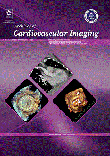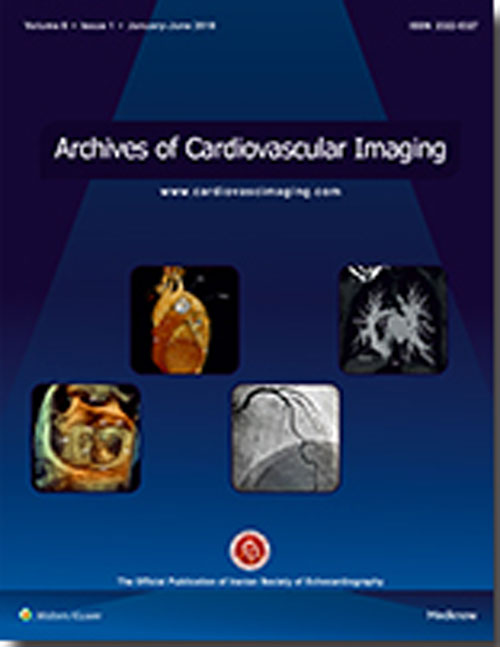فهرست مطالب

Archives Of Cardiovascular Imaging
Volume:3 Issue: 4, Nov 2015
- تاریخ انتشار: 1394/09/30
- تعداد عناوین: 6
-
-
Page 1IntroductionHeart failure is the second most common cause of ascites after cirrhosis. There are cardiac and noncardiac etiologies of ascites, and the multimodality imaging approach is a rich tool to redefine the final diagnosis..Case PresentationWe present a case-series where 3 patients were referred to our hospital for further hepatology assessment due to severe abdominal ascites and liver failure. Constrictive pericarditis was diagnosed in all of them. Nowadays, constrictive pericarditis is a well-known disease, but sometimes its clinical presentation may delay the treatment and worsen the prognosis. Our 3 cases had similar clinical scenarios and hemodynamic patterns when undergoing right-heart catheterization, but they had different anatomical pericardium-compromise, requiring different surgical strategies..ConclusionsNowadays, multimodality imaging, especially cardiac magnetic resonance imaging and cardiac computed tomography, allows us to study a wide spectrum of the same disease in terms of anatomical compromise and cardiac physiology in order to stratify different prognosis and treatment options. We describe 3 unusual clinical cases where the initial differential diagnosis denoted noncardiac etiologies. The level of serum NT-proBNP proved pivotal to the redefinition of the clinical scenario and differentiation between the cardiac and noncardiac etiologies of new-onset ascites. A multidisciplinary approach in this setting between internists, hepatologists, and cardiologists was helpful to establish the final diagnosis in all the patients.Keywords: Constrictive Pericarditis, Liver Failure, Cardiac MRI, Cardiac CT, Pericardiectomy
-
Page 3BackgroundLeft atrial function can be critical for risk assessment and prediction of adverse cardiac events. Tissue Doppler of atrial contraction can provide regional and global snapshots of atrial systolic function..ObjectivesThe present study aimed to assess left atrial function by tissue Doppler parameters of strain and strain rate following percutaneous coronary intervention (PCI)..
Patients andMethodsThis prospective study recruited 77 consecutive patients with coronary artery disease who underwent PCI. The study end point was to assess left atrial function by regional strain and strain rate parameters before and after PCI via tissue Doppler imaging..ResultsRegarding changes in left trial functional parameters after PCI, those such as the strain of the septal wall and the anterior and inferior walls and the strain rate of the anterior and lateral walls significantly increased following PCI, while the strain of the lateral wall and the strain rate of the septal wall significantly decreased..ConclusionsPCI was accompanied by some improvement in left atrial deformation indices as assessed by tissue Doppler imaging. Revascularization can, therefore, improve patient outcome..Keywords: Strain, Strain Rate, PCI -
Page 4The right ventricle (RV) is a complex structure with abstruse function that reveals important differences when compared to the left ventricle (LV), so it cannot be described as a simple geometric form and achromatic physiology. As an inference from this fact, in the present review, we aim to describe RV structure including the embryology, anatomy, and physiology and present a functional, hemodynamic, and imaging assessment of the normal and failing RV. So that, we conducted a thorough review based on the database sources such as MEDLINE, PubMed, Cochrane and Google scholar. No restrictions were placed on study date, study design, or language of publication. We searched all valuable and relevant information considering the anatomy, physiology, mechanics, hemodynamic and imaging evaluation of RV..Keywords: Right Ventricular Anatomy, Right Ventricular Physiology, Right Ventricular Mechanics, Right Ventricular Hemodynamic, Right Ventricular Function, Right Ventricular Imaging
-
Page 5BackgroundStress echocardiography represents one of the best possible imaging choice for the diagnosis and stratification of patients with coronary artery disease (CAD). However, this imaging technique presents some limitations such as the quality of the image, high inter-observer variability, and the operator-dependent expertise. New technologies have been recently developed to provide an objective, operator-independent, and quantitative analysis of regional myocardial function..ObjectivesThe aim of this study was to investigate regional myocardial dyssynchrony using tissue synchronization imaging (TSI) during exercise stress echocardiography (ESE)..
Patients andMethodsThe ESE and TSI analysis of left ventricular (LV) segments was performed for 30 patients with CAD previously treated with revascularization therapy (CADr group) and the results were compared to those in 30 healthy subjects (norm group). The echo protocol comprised echocardiographic examinations at baseline, at the peak of exercise, and at 5 minutes after recovery as well as biplane and triplane acquisitions, pulsed wave of mitral flow, continuous wave of tricuspid regurgitation, tissue Doppler at the mitral annulus, TSI with an automatically detected positive time-to-peak velocity (Tp), and the measurement of the maximum activation time delay between myocardial segments and its standard deviation at baseline and peak stress for each patient..ResultsThe CADr group showed a lower increase in E (P = 0.005), A (P = 0.006), S (PConclusionsThe TSI analysis in patients with CAD may be considered an interesting parameter in addition to the conventional echocardiographic parameters during ESE..Keywords: Coronary Artery Disease, Stress Echocardiography, Tissue Synchronization Imaging -
Page 6IntroductionTakotsubo syndrome (TKS) is generally caused by a stressful condition, and it usually has a good prognosis after the recovery of left ventricular function. About 70% of the cases of hypertrophic cardiomyopathy may develop obstruction in the left ventricular outflow tract (LVOT), which is responsible for heart failure..Case PresentationWe present a unique case where TKS occurred in a middle-aged male patient with hypertrophic obstructive cardiomyopathy (HOCM) without a clearly identifiable initial stress trigger..ConclusionsIn the setting of acute left ventricular function depression in HOCM, a comprehensive differential diagnosis should be established. Treatment should be based on hemodynamic changes. After recovery, the prognosis is related to HOCM..Keywords: Hypertrophic Cardiomyopathy, Takotsubo Cardiomyopathy, Heart Failure


